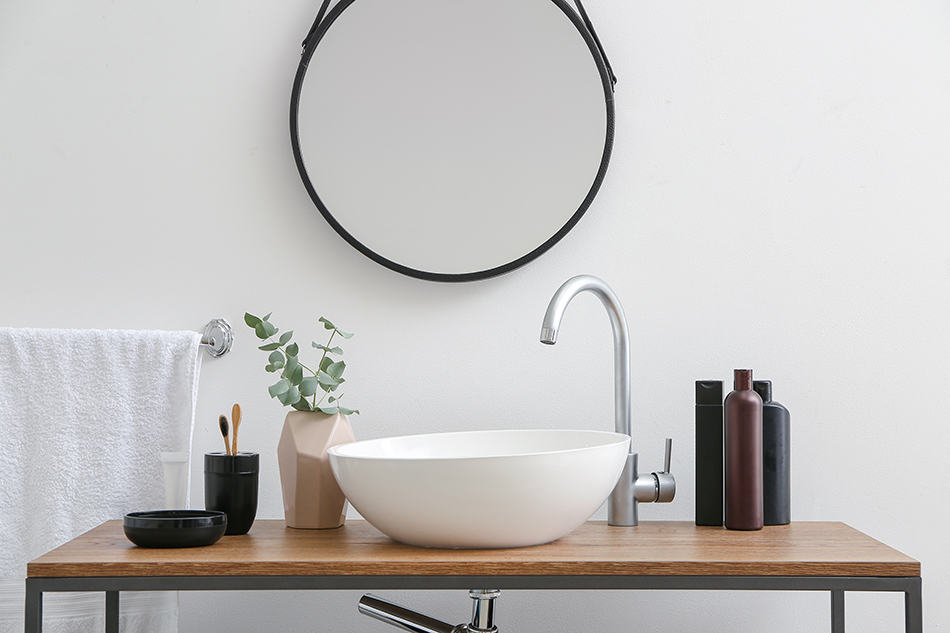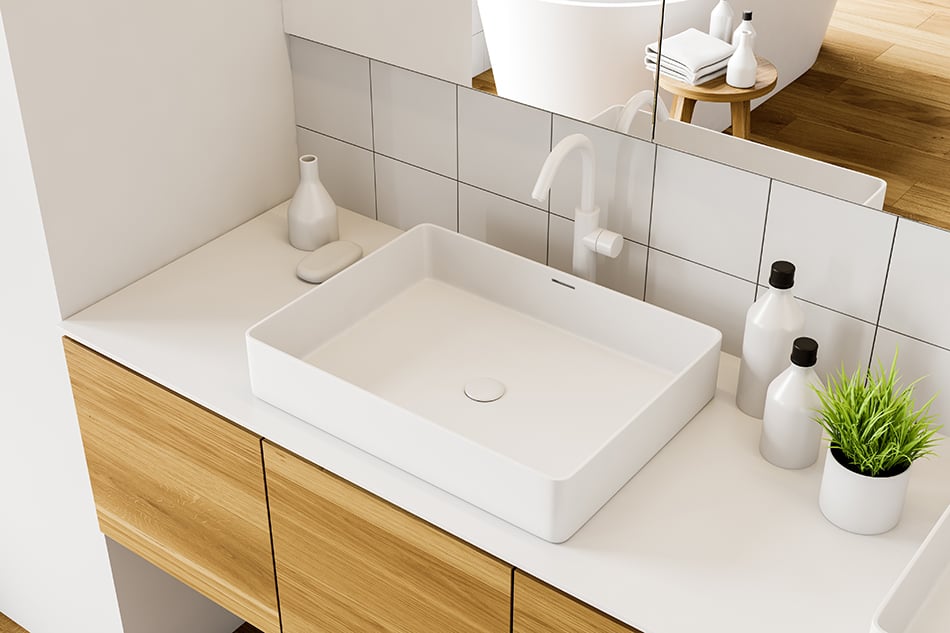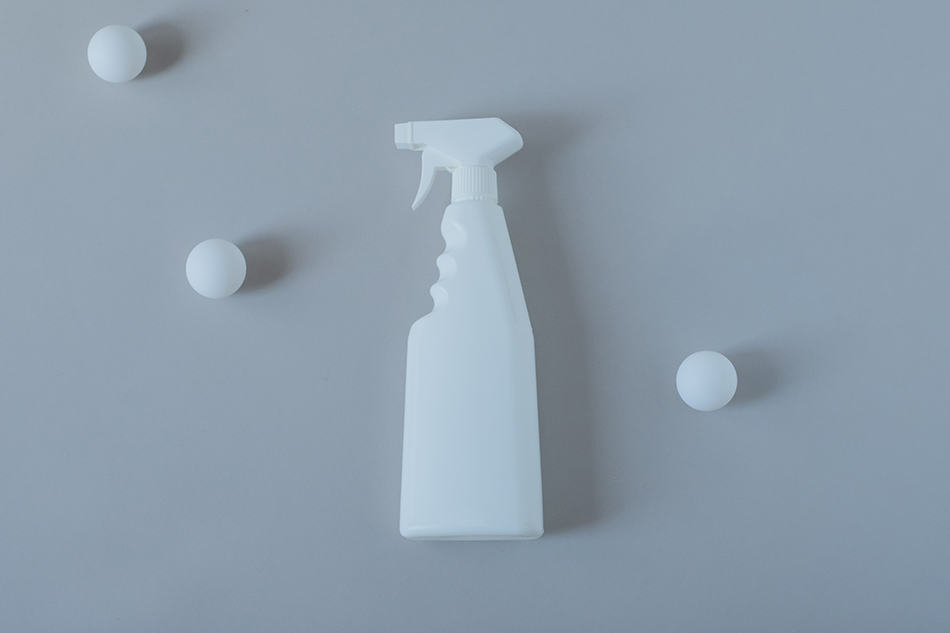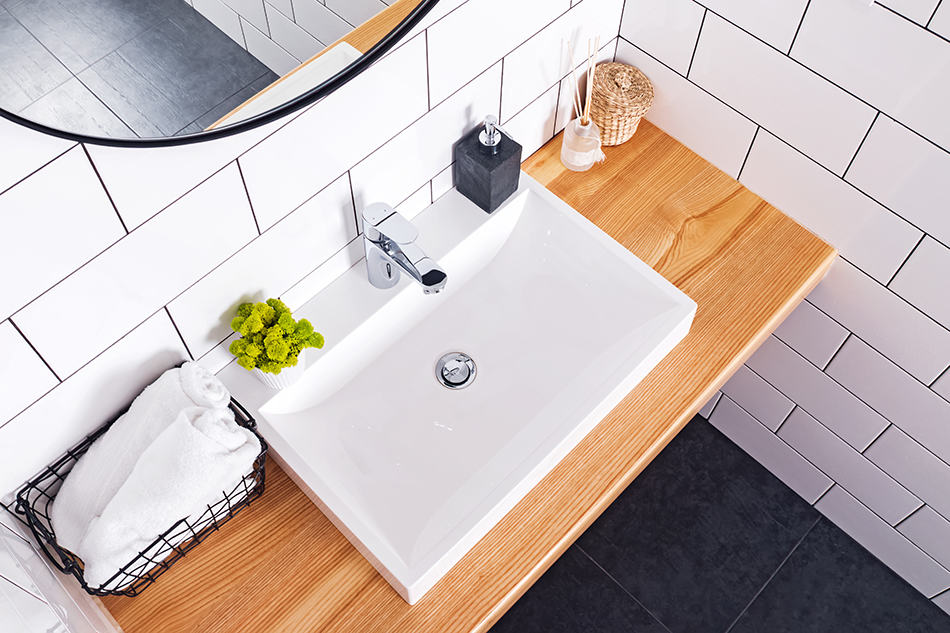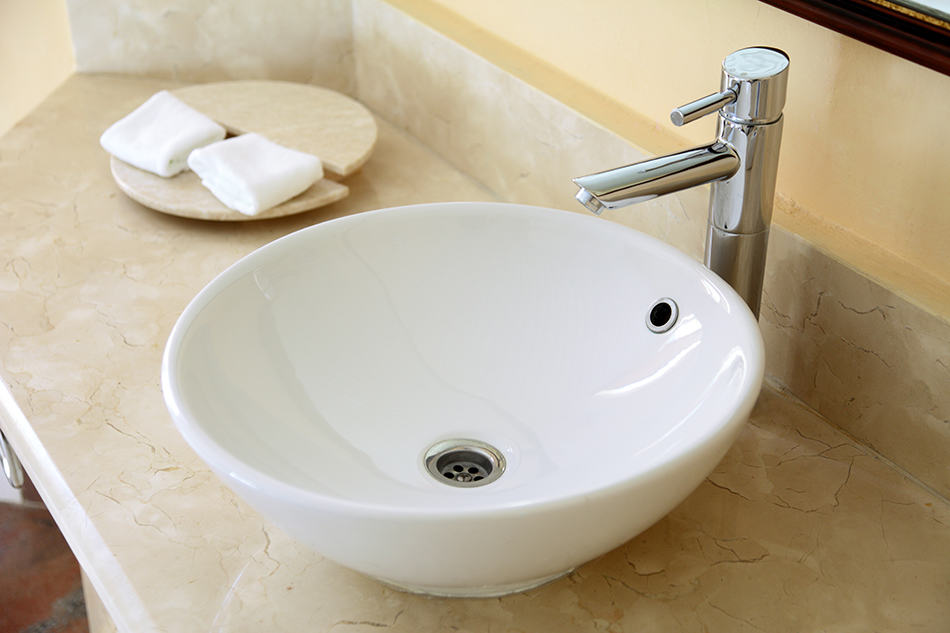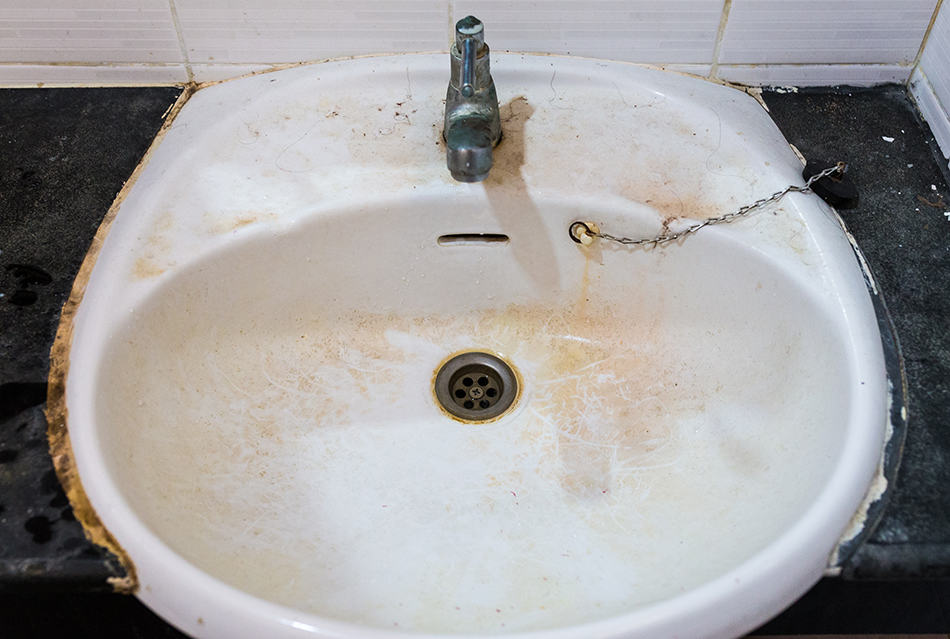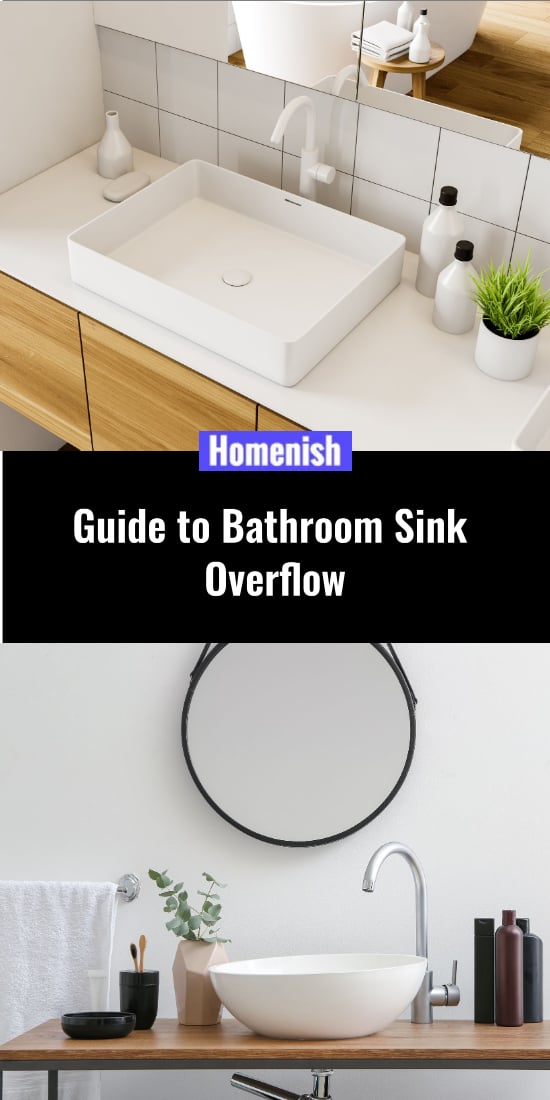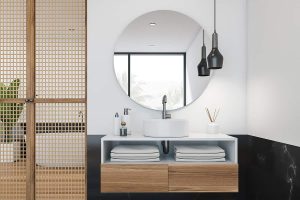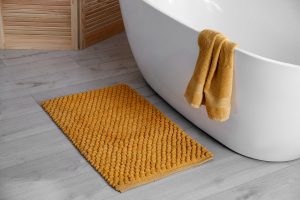If you have ever taken a look underneath your bathroom faucet, you may have noticed that there is a small hole toward the back of the sink. That’s an overflow, which many people don’t tend to pay much attention to.
However, knowing the importance of this bathroom sink space can help keep your drain clean and odor-free. We will explain everything you need to know about the function of bathroom sink overflow, how to clean it properly and your options in buying the right drain with overflow.
The Purpose of an Overflow Hole?
The one purpose of an overflow hole is to keep the bathroom sink from flooding in the event of leaving the faucet on accidentally or having a plumbing issue. The overflow prevents flooding by diverting the excess water.
This hole also helps the basin drain quicker by allowing air into the pipe via the overflow channel. When the water completely covers the drain opening, the air gets trapped through the water, thus creating a suction effect that slows down the water flow. The overflow feeds the air to the drain pipe and, as a result, reduces the suction effect, which helps water drain faster.
Sinks that don’t have overflow openings often send up air bubbles as they drain the water. In addition, water drains more slowly in such sinks.
How the Sink Overflow Functions
Most sink overflow holes are hidden along the underside of the sink basin. In most cases, they are not visible from the top of the sink or from below it. There are two holes close to the rim of the basin at the top of the overflow channel.
The bottom part has an outlet hole that allows water to flow into the drain. This channel is located just below the basin. Both the overflow and basin empty into the same drain pipe, but the main difference between them is that the overflow is always open.
How to Prevent Water from Overflowing
So by now, you have learned the purpose of a bathroom sink overflow and how it works. If you close the drain and fill up the basin up to the overflow hole level, the water will start draining into the overflow opening. While this prevents the water from spilling over, it won’t prevent an overflow for long because the sink overflow holes are normally very small.
If you run the water at full volume, the overflow channel will only delay the water overflow for a short time. Most people are under the impression that a sink overflow will prevent water from overflowing when the sink drain is clogged. However, this is not the case. The overflow outlet is located very close to the drain opening so it’s unlikely that a clogged drain will be rectified by an overflow.
The job of a bathroom sink overflow is to protect against overflow when the drain stopper is closed, and the faucet is left running – not when there is a clog in the sink. The overflow drains in tubs work a little differently as there is more distance between the opening and the connection. If the clog is close to the drain opening, the overflow fitting can still work to prevent water from overflowing.
As you can imagine, it’s highly important to keep the overflow hole unclogged. Otherwise, it won’t function properly. By keeping the hole clean, your bathroom overflow can do its job and prevent mold or mildew from standing water. Since the bathroom is a damp place, the last thing you want to happen is to walk into a blocked sink overflow drain with condensation everywhere.
To unblock your bathroom sink overflow, you will need the following:
- A pipe cleaner or sink-cleaning brush
- A funnel made from a material that can withstand boiling water temperature
- 2 to 3 gallons of boiling water
Step 1. Push the brush or pipe cleaner into the overflow hole.
Step 2. By pushing the brush in and out several times, try to remove as much debris or gunk as possible.
Step 3. Boil up to 3 gallons of water.
Step 4. Slowly pour the boiling water into the hole to loosen the remaining buildup. Caution: be careful with the boiling water as you don’t want to splash it on yourself and get burned!
Step 5. Repeat the boiling water process as needed.
How to Clean a Smelly Overflow
While boiling water will unclog the sink drain and prevent overflowing, it won’t get rid of the unpleasant odor of mildew. Mold or mildew can build up in the sink and cause a nasty smell. But you don’t have to tolerate the odor as there are some simple ways to get rid of the stench.
To tackle the smell, you’ll need the following:
- 1 cup of white vinegar
- 1 cup of baking soda
- Boiling water
- A funnel made of silicone to withstand heat
Step 1. Place the funnel into the overflow hole.
Step 2. Pour the baking soda through the funnel.
Step 3. Pour the vinegar through the funnel and wait for the fizz. This is because of the soda and vinegar mixture.
Step 4. Let the soda and vinegar work their magic for 20 minutes or so.
Step 5. Now flush the sink with boiling water. Again be careful when doing this as you don’t want to burn yourself.
Step 6. If the odor remains, repeat the same steps as needed.
Using an Enzyme Cleaner
Enzyme cleaners are also ideal for cleaning a bathroom sink overflow hole. These products absorb through the organic bacteria, and some even have odor-neutralizing effects.
Enzyme cleaners come in powder or liquid forms. If buying the powder form, it will need to be mixed with water before pouring it in the drain. You must then run some water to let it pass through the drain pipe. The liquid form, on the other hand, is ready to use without the need to mix it with water.
Whichever enzyme cleaner you choose will give you the results you want. All you have to do is pour the product into the sink overflow hole and let it sit overnight.
The next day, pour some warm water into the drain pipe to flush out the enzyme cleaner.
As you can see, keeping your overflow hole clean and odor-free doesn’t take a lot of effort or time. By regularly checking and cleaning the drain, you can prevent musty odor and keep your drain pipe in optimal condition.
How to Choose a Bathroom Sink Drain with Overflow
Bathroom sinks with overflow allow an extra line of protection in the event the drain is blocked and water is left running. The overflow also offers additional airflow, which helps create suction to allow water to flow more quickly down the drain. Interestingly enough, most bathroom sinks don’t come with an overflow feature, even though this feature is highly necessary to ensure a well-functioning sink.
To help you choose the right sink with overflow, here are all your drain options:
Press and seal: also called a pop-up drain, the press and seal drain is easy to install and operate. The mechanism is activated by simply pressing down the drain cover.
Twist and turn drain: sometimes called a lift and turn drain, the twist and turn features a small pointer that’s used to lift the drain cover manually. Just like the pop-up drain, this is another easy-to-install and operate type of drain. The twist and turn drain is closed by pressing down the drain cover and twisting it to hold it in place.
Grid drain: drains with strainers or grids often appear in bathroom sinks that have no closing function. The grid on the drain allows the water to flow through at all times, while the strainer blocks larger items from passing down the drain.
Chain and plug drain: this type of drain is operated manually by plugging and removing the stopper. The chain and plug drains come with a small mesh basket that prevents unwanted items from falling into the drain.
Pop-up rod drain: these drains feature stoppers and lift rods that function by pulling up the lift rod located at the faucet’s back. The lift rod is attached to the underneath of the drain sink and will lift and close the cover.
Warning: if you choose a bathroom sink without overflow, a pop-up drain would not be a wise choice. This is because if the drain was to close and the water left running, the sink will overflow and flood your bathroom.
For bathroom sinks that don’t come with drains, you can find the right sink drains that contain a mesh. Simply choose from the list above and incorporate it into your bathroom style. Follow a few simple steps to ensure you find the right drain:
Step 1. Measure your bathroom sink. Keep in mind that the bathroom sink’s drain needs to fit the opening to work properly. Measure the opening first to ensure you get the right size drain. Most drain openings sizes are 1.5 inches, although you can find smaller sizes as standard.
Step 2. Set a budget. There are many different bathroom sink drains in a wide range of prices. It is, therefore, important to set a budget before you start looking. To give you an idea, prices can vary between $20 and $40 with all kinds of materials and finishes. If you choose to buy a drain online, be sure to check its specific size and always buy from a reputable supplier.
Step 3. Choose your drain from the list above. From grid drains to chains and plugs, you can find different types depending on your needs. Grid drains have small holes that can’t be closed, while pop-up drains allow water to build up in the sink, so you must install an overflow to prevent flooding.
Pop-up drains typically open and close through a lever located behind the faucet. These drains are ideal for those who need to fill the sink with water for shaving, for example. However, grid drains make a better choice as they have small holes to allow water to flow while catching larger items to prevent clogs.
Step 4. Overflow is important. While overflow is an optional feature, it does have its advantages. This small opening in the sink will let the airflow into the drain and prevent flooding at the same time. Bathroom sinks without overflow will soon start giving off an unpleasant odor so it’s not advisable to install a sink without overflow.
Even if your chosen bathroom sink drain doesn’t come with an overflow hole, it is possible to add this feature yourself. If you’re not familiar with plumbing, get a professional plumber to install the overflow for you.
Step 5. Think about the style and material of your sink. When choosing a sink, make sure your bathroom’s design complements the sink. This doesn’t mean the drain needs to be the same finish as the faucet. In fact, it can be made from a different material but in the same color.
Some of the most popular bathroom sink drains are made of brass, which is a durable and highly attractive material. It’s also common to see bronze and stainless steel drains on the market.
Bronze is an eye-catching and versatile drain that blends well with copper sinks. It also stands out when used in concrete sinks. For a cheaper and shinier option, you may choose a nickel finish. All you have to do is clean it from time to time to retain its appearance.
For modern bathroom drains, chrome makes a great choice, particularly when it’s matched with a chrome faucet.
Pro tip: if your bathroom sink is positioned above the countertop rather than being a recessed sink, choose a drain that comes with a mounting ring. This feature supports the sink since it isn’t attached to a cabinet.
We hope this article has provided you with all the information you needed about bathroom sink overflow. Now that you’ve learned about the importance of this feature, you can choose the right drain for your sink.
